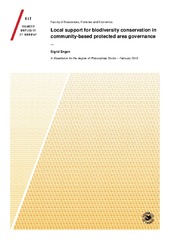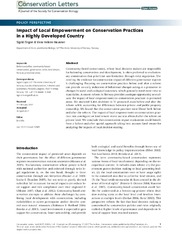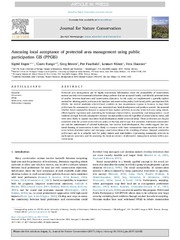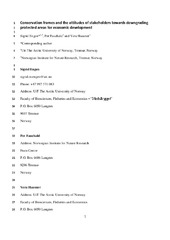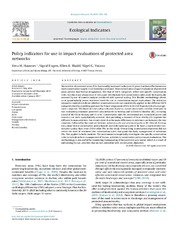| dc.contributor.advisor | Vera, Hausner | |
| dc.contributor.author | Engen, Sigrid | |
| dc.date.accessioned | 2018-06-22T10:54:47Z | |
| dc.date.available | 2018-06-22T10:54:47Z | |
| dc.date.issued | 2018-06-13 | |
| dc.description.abstract | Worldwide there have been many attempts to implement community-based conservation to gain a more inclusive protection of biological diversity. Reducing human pressures on ecosystems is necessary for favorable ecological outcomes of protected areas, but conservation initiatives that rely on strict enforcement without local support are vulnerable to rule-violations, public protests and a reduced political commitment. The Norwegian government decided in 2009 to employ a community-based conservation strategy for protected areas in Norway, and in this thesis I explore whether the reform has led to less local resistance towards conservation and reduced threats to biodiversity. Included are four studies that shed light on this main research question.
In this thesis, I investigate the strictness level of the current conservation policy and the local acceptance of spatially restricting resource use. I evaluate the impact of the Norwegian community-based conservation reform on the local decisions to regulate use, and analyze the views of conservation among local stakeholders.
This thesis shows that community-based conservation has accommodated local needs through a less strict conservation practice on private land. The local residents living near the protected areas seemed to accept the idea of restricting residential and industrial development inside protected areas, whereas a large proportion of key local stakeholders were less supportive of prioritizing conservation over economic development. The reform includes two governance bodies that are trusted by stakeholders holding different views of conservation, which suggests that local protected area boards along with stakeholder advisory councils could be in a good position to reconcile contrasting views of conservation.
The overall liberal conservation policy and practice makes it reasonable to question the impact protected areas have on reducing threats to biodiversity. The pressure for human activities is high in mountain areas and combined with a more lenient conservation practice this could reduce protected area effectiveness. Therefore I suggest that more attention should be devoted to the impact protected areas have on reducing human activities that pose a threat to biodiversity, compared with a situation without protection. | en_US |
| dc.description.doctoraltype | ph.d. | en_US |
| dc.description.popularabstract | Community-based conservation has been proposed as a solution to environmental problems based on the idea that if conservation and development can be simultaneously achieved then, the interests of both can be served. The Norwegian government decided in 2009 to employ a community-based conservation strategy for protected areas in Norway, and this thesis explores whether the reform has led to less local resistance towards conservation and reduced threats to biodiversity. The results show that community-based conservation has accommodated local needs through a less strict conservation practice on private land. Local residents living near the protected areas seemed to accept the idea of restricting residential and industrial development inside protected areas, whereas a large proportion of key local stakeholders are less supportive of prioritizing conservation over economic development. These results call for greater attention to stakeholder participation and conservation impact assessments. | en_US |
| dc.description.sponsorship | This work was funded by CultES – Assessing spatially explicit cultural ecosystem services for
adaptive management in the Alpine North, Norwegian Research Council nr.
230330/E50/2014 | en_US |
| dc.identifier.isbn | 978-82-8266-154-6 | |
| dc.identifier.uri | https://hdl.handle.net/10037/12971 | |
| dc.language.iso | eng | en_US |
| dc.publisher | UiT The Arctic University of Norway | en_US |
| dc.publisher | UiT Norges arktiske universitet | en_US |
| dc.rights.accessRights | openAccess | en_US |
| dc.rights.holder | Copyright 2018 The Author(s) | |
| dc.rights.uri | https://creativecommons.org/licenses/by-nc-sa/3.0 | en_US |
| dc.rights | Attribution-NonCommercial-ShareAlike 3.0 Unported (CC BY-NC-SA 3.0) | en_US |
| dc.subject | ressursforvaltning | en_US |
| dc.subject | VDP::Matematikk og Naturvitenskap: 400 | en_US |
| dc.subject | VDP::Mathematics and natural science: 400 | en_US |
| dc.title | Local support for biodiversity conservation in community-based protected area governance | en_US |
| dc.type | Doctoral thesis | en_US |
| dc.type | Doktorgradsavhandling | en_US |


 English
English norsk
norsk